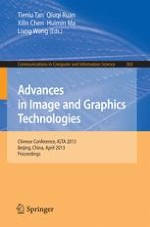2013 | Buch
Advances in Image and Graphics Technologies
Chinese Conference, IGTA 2013, Beijing, China, April 2-3, 2013. Proceedings
herausgegeben von: Tieniu Tan, Qiuqi Ruan, Xilin Chen, Huimin Ma, Liang Wang
Verlag: Springer Berlin Heidelberg
Buchreihe : Communications in Computer and Information Science
